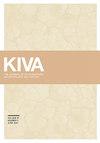An Early Military Macaw from Cueva de Avendaños, Chihuahua
IF 0.4
0 ARCHAEOLOGY
Kiva-Journal of Southwestern Anthropology and History
Pub Date : 2021-01-02
DOI:10.1080/00231940.2020.1870030
引用次数: 4
Abstract
During a 2016 archaeological salvage project in the municipality of San Francisco de Borja, Chihuahua, the mummified head of an adult military macaw (Ara militaris) was recorded from a rock shelter. Because of their aesthetic beauty and colorful plumage, macaws occupied an important place within the collective imagination of the pre-Hispanic communities. Macaws and macaw feathers also were important ritual and social symbols, often used in Pueblo ceremonial regalia. Radiocarbon analysis of the macaw has produced a Late Archaic calibrated date range of 150 BC – AD 20, making this the earliest macaw by several hundred years in northwestern Mexico or the southwestern United States. Stable carbon isotopes in this macaw were comparable to maize-fed domesticated turkeys from the Southwest suggesting some form of animal husbandry by this time. Our discussion includes comparison with the handful of other military macaws from pre-Hispanic contexts in northwestern Mexico and the southwestern United States.奇瓦瓦阿文达尼奥斯洞穴的早期军用猕猴
2016年,在奇瓦瓦州旧金山德博尔亚市的一个考古打捞项目中,一只成年军事金刚鹦鹉(Ara militari)的头部木乃伊在岩石避难所被记录下来。由于其美丽的美学和丰富多彩的羽毛,金刚鹦鹉在前西班牙裔社区的集体想象中占有重要地位。金刚鹦鹉和金刚鹦鹉羽毛也是重要的仪式和社会象征,经常用于普韦布洛的仪式服饰。对金刚鹦鹉的放射性碳分析得出了公元前150年至公元20年的晚期古猿校准日期范围,使其成为墨西哥西北部或美国西南部数百年来最早的金刚鹦鹉。这种金刚鹦鹉体内的稳定碳同位素与来自西南部的玉米饲养的驯养火鸡相当,这表明当时存在某种形式的畜牧业。我们的讨论包括与墨西哥西北部和美国西南部前西班牙裔背景下的少数其他军用金刚鹦鹉进行比较。
本文章由计算机程序翻译,如有差异,请以英文原文为准。
求助全文
约1分钟内获得全文
求助全文
来源期刊
CiteScore
0.70
自引率
33.30%
发文量
31

 求助内容:
求助内容: 应助结果提醒方式:
应助结果提醒方式:


